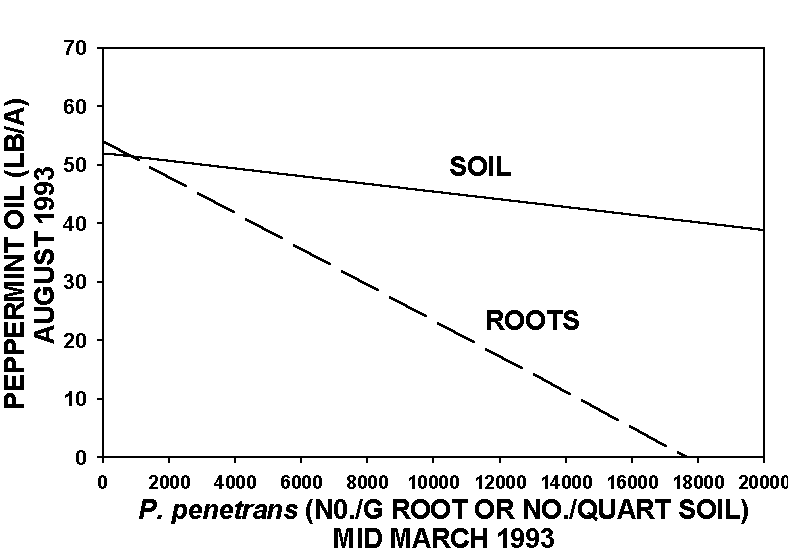|
USING ECONOMIC INJURY LEVELS |
|
CONTENTS [Return to Post-plant Options] |
Data on the relationship between root-lesion nematode density and mint yield
have been examined with a number of mathematical functions but the simplest and most
descriptive equation was determined to be:Y = a - bx
where:
Figure 1. Effect of root-lesion nematodes (Pratylenchus penetrans) on peppermint yield (lb oil/A) in the Willamette Valley during 1993. Calculated based on 85 plots from 4 sites. For example, the relationship between nematode density and yield for the data from the 85 plots shown in Figure 1 can be expressed as: Y = 52 - 0.0005x, R = 0.61 for nematodes/quart soil and Y = 58 - 0.0045x, R = 0.59 for nematodes/g fresh root T he relationship between nematode density and yield for the data from the 30 plots shown in Figure 2 below can be expressed as:Y = 52 - 0.0006x, R = 0.76 for nematodes/quart soil and Y = 54 - 0.0031x, R = 0.60 for nematodes/g fresh root
Figure 2. Effect of root-lesion nematodes (Pratylenchus penetrans) on peppermint yield (lb oil/A) in the Willamette Valley during 1993. Based on measured populations from 30 plots in 3 sites. Most of the data which have been collected to determine these relationships have come from stressed fields which produce less than the average amount of oil/A. Since severe nematode stress can take years to reverse, even plots where nematodes had been reduced to zero, after a single treatment, have yields that are less than normal. In addition, many factors affect yield besides nematodes. Therefore, attempting to predict oil yield from any given field based solely on nematode densities may not be particularly successful. A more relevant use of these functions is to estimate the amount of oil reduction which is likely to occur based on the nematode density present in that field. Then, based on the expected price/lb of oil and the cost of treatment, it can be determined how many lb of oil it will take to pay for the treatment. Nematodes should be treated when densities are above the level that would reduce yield by this amount. ExampleThe results from the small (30 plot) data set estimate that one pound of oil is lost for each increment of 322 (1/b = 1/0.0031) P. penetrans/g root or each 1,667 (1/b = 1/0.0006) P. penetrans/quart soil found in mid-March. Thus, when a nematode sample is taken, the numbers of P. penetrans/g root should be divided by 322 to estimate the pounds of oil that may be lost and the number of P. penetrans/quart soil should be divided by 1,667 to estimate the pounds of oil that may be lost. The two estimates should then be averaged to get the best estimate of the amount of oil that may be lost due to the nematode density present in that sample. Using a soil or root sample only is not as good but, between the two, using a soil sample is slightly better since there tends to be less variance around soil population estimates (Ingham, 1994). This procedure was tested with data obtained from a trial in 1994 which had 25 Vydate treated plots and 25 nontreated plots. Average soil population in the 50 plots on March 17 was 5,492/quart soil and the average root population was 1,598/g root. Thus, the soil population divided by 1,667 estimated a loss of 3.3 lb oil/A and dividing the root population by 322 estimated a yield reduction of 5.0 lb oil/A. The average of these two estimates is 4.1 lb oil/A. The difference in oil yield between treated plots (51.6 lb/A) and nontreated plots (47.5 lb/A) was 4.1 lb oil/A. Thus, the predicted loss was very close to the actual gain by treating with Vydate. Using the data from the large (85 plots) data set estimated a loss of 5.0 lb oil/A which was also a close approximation. This may actually be a more accurate estimate since treatment with Vydate is not likely to compensate for all the yield loss from nematode damage at these densities. These threshold values may be very conservative estimates, however. The functions were developed during a mild year when there was probably less than normal nematode stress (1993) and tested in 1994 which also appeared to be a relatively low nematode stress year. It is estimated that this same amount of yield loss would have been caused in 1990 and 1991 by 1/2 - 1/3 the densities reported here. More information is necessary on how environmental factors and other variables, such as soil type, cultivar etc., influence the damage predicted from threshold levels. |


